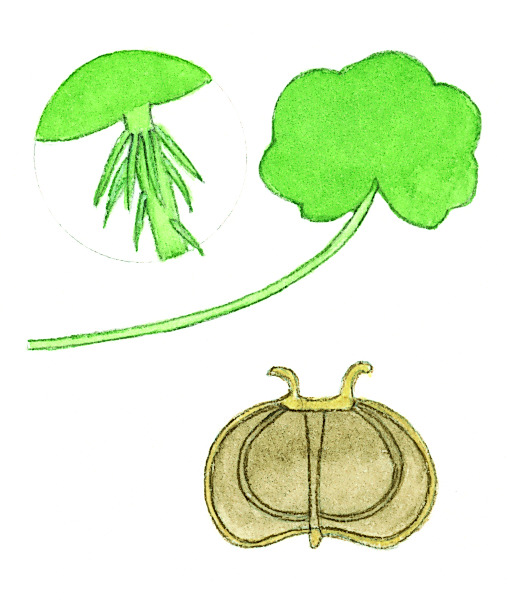Hydrocotyle sibthorpioides
Lam.Perennial procumbent herb, occasionally forming mats, usually glabrous, stems creeping, rooting at nodes. Leaf-lamina c. circular, cordate or reniform, 5–33 mm across, margins entire or shallowly (rarely deeply) 3–7-lobed, crenate, adaxial surface glabrous to glabrescent, often shining, abaxial surface sparsely and finely hispid; petiole 3–5.5(–16) cm long, often with a few long deflexed hairs just below lamina; stipules broad, scarious and overlapping, entire. Umbels simple, leaf-opposed, globose, 2–5 mm diam., 10–12-flowered; peduncle 4–11 mm long; pedicels to c. 1 mm long. Petals c. 0.75 mm long, yellow-white, often purple tinged. Fruits c. 1 mm long and wide, surface smooth to tuberculate, sometimes blotched red; mericarps with prominent dorsal rib and prominent curved intermediate ribs. Flowers spring-autumn.
LoM, MuM, Wim, GleP, Brid, VVP, VRiv, MuF, GipP, OtP, WaP, Gold, CVU, GGr, DunT, NIS, EGL, EGU, WPro, HSF, HNF, OtR, Strz, MonT, HFE, VAlp. Also NSW, Tas. New Guinea. Widespread, usually growing along or in watercourses, or in moist areas of sclerophyll forests and swamps; also a common weed of well-watered lawns.
A variable species and research is required to determine if any of the variants warrant taxonomic recognition. Hydrocotyle sibthorpioides can be distinguished, from the similar H. hirta and H. algida, by being glabrous or glabrescent with fine straight hairs on the adaxial surface of the leaves, and by often having a 'frill' of long deflexed hairs just below the leaf-lamina.
Duretto, M.F. (1999). Apiaceae. In: Walsh, N.G.; Entwisle, T.J., Flora of Victoria Vol. 4, Cornaceae to Asteraceae, pp. 256–258. Inkata Press, Melbourne.
 Spinning
Spinning
